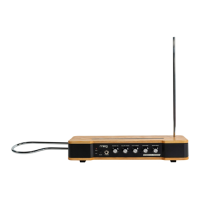16
PLAYING EXERCISES AND TECHNIQUES
The theremin has been described as one of the most dicult instruments to play due to the lack of a
physical interface. Unlike an instrument that provides physical feedback as to where each note lies, the
thereminist must rely strictly on their ears to find each note. The most dicult obstacle to overcome
is learning to control both the pitch and volume simultaneously. While each gesture by itself is quite
simple, performing these two motions at the same time can feel a bit awkward. Fortunately, all it takes
is a little practice. If you use your hands to hold utensils while you eat, you’ll be fine.
PITCH HAND EXERCISES
1. Hum a note. Moving only your pitch hand,
try to find that same note. When you find it,
hold it steady and hum another note just a
few tones higher.
2. Now gradually extend your fingers to
raise the pitch and “glide” to the new note.
This glide is called a glissando.
3. Now slide back down to the first note.
NOTE: You can use an instrument tuner
(connected to the PHONES or AUDIO OUT jack
of your Etherwave Theremin) as a visual aid to
help guide you, but more importantly, listen
to the change and distinct sound of each note.
4. Now hum a third note that is slightly higher than the second. Play the first note, slide to the second,
pause, and then glide to the third.
5. Start at the third note and then play down to the first.
Practice this a few times, going up and down, making sure to hit the same three notes. Gradually speed
up, while keeping your movements smooth and graceful. Pay attention to how much movement is
needed to reach each note. Try to repeat the same movements and finger positions.
When you can consistently glide back and forth across three notes, try this:
Start at the first note again, but rather than
gliding up, make a quick jump to the second
note. This will require snapping your hand
into the second note position with an abrupt
change. This creates the stepped sound of
two distinct notes.
Playing notes together like this, with no
space in between, is referred to as legato.
Practice snapping the three notes in order,
up and down; then, try larger jumps—
snapping from note one to note three.
Experiment by mixing combinations of
legato and glissando.
LEGATO
Quick snap to the next note
GLISSANDO
Glide to the next note

